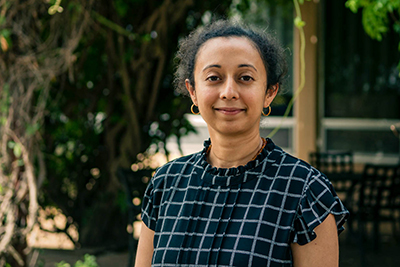 Menu
Menu

By Megan Wagner, MH ’16
Associate Professor of Cybersecurity Renita Murimi, Ph.D., CISSP, has been on the frontlines of blockchain technology. Murimi began teaching in the Gupta College of Business in fall 2019. She recently launched the blockchain company WildChain, which will aid in global conservation efforts. We wanted to learn more about how this incredible idea came about and the waves it will make in the world of conservation.
Can you explain what blockchain technology is and how it works?
Blockchain is a system for keeping records. It is a distributed database in which copies of records are distributed to and stored on several computers. There is no central computer or server. If 50% or more of the computers in the network acknowledge that the copy is correct, that record is verified and saved. The record is stored in a “block” and is added to a chain of blocks composed of saved information. Blockchain prides itself on being distributed and immutable. The immutability comes from using hashing to provide assurance against tampering. For example, when passwords are created, they are passed through a hashing function. A simple password, like a name, is given a value. The more complex the hashing function, the more secure the information. The motivation behind blockchain is security; it proves the integrity of the data. A complex hash is calculated for the record or transaction, and the hash is what is stored in the blockchain.
Blockchain has been a long time coming. The first application of blockchain was in 2008. There was a mysterious entity who published a concise white paper explaining how the new technology could be used to create Bitcoin. It proposed a new way to process currency. Bitcoin is one application of blockchain.
In explaining blockchain, the word “transaction” is used loosely. The records stored could be financial, but they could also be any type of record. Because of the security and immutability, more governments and organizations are switching to blockchain technology. Things like car titles and home deeds can be stored securely in blockchain. Walmart was an early adopter of this technology; they contracted with IBM, and IBM used blockchain to create a supply chain. Blockchain is helpful in tracking fair trade items, seafood and any number of products.
Tell me about your background and how the idea for WildChain came about.
I started my research in blockchain in 2018. In my field, we publish in conferences or in journals and subscribe to mailing lists in our discipline. There was a conference at MIT in 2018, and though I was not deeply into blockchain, I decided to submit my research and paper, and they were accepted! What started as a side interest has now become a huge part of my research portfolio, and I am very interested in the blockchain ecosystem.
The Frankfurt School Blockchain Center in Germany made a goal of increasing female presence in blockchain technology. In order to do so, they initiated a program called DLT Talents. I applied and was accepted. The group is made up of about 40 women from around the world. It is an 18-week program. We meet every other Monday online and have assignments and speakers. It is an incredible opportunity to be part of a group that empowers females and fosters leadership within the industry.
Through this opportunity, I learned about a funding competition through Sperax. They launched the LIFTED initiative, a funding competition aimed to support women in blockchain. For the competition, I came up with the idea to create NFTs (nonfungible tokens) for conservation. Conservation agencies already have content online (much like sports), but through the selling of NFTs, they will receive a portion of the revenue. The NFTs are unique. It might be video, audio or an image of a rare species of an animal doing something unique. NFTs are creating a frenzy in the art world, as people can buy original digital art. You treat NFTs like stock: You can buy, sell and expect the value to change over time. Digital files can be collected like tokens.
I have a passion for conservation and have always had an interest in finding ways to add tree cover, reduce water usage, etc., because we are losing animals and tree cover. The idea for WildChain came out of a long time of reflecting on these issues. There is a possibility of a future name change from WildChain to WildernessChain.
Where are you in the launch process for WildChain?
We currently have a working prototype and are working to grow the company. The prototype launched in April, which is how we were able to receive grant funding. We are trying to formalize partnerships with zoos and conservation agencies now as well.
Who has been working with you on the project?
Early on I reached out to the Computer Science Department, and Assistant Professor Robert Hochberg, Ph.D., put me in touch with two students. I have had one undergraduate student and one graduate student completing an internship for WildChain. UD senior Clarissa Skipworth and Minh Ly, who is enrolled in the M.S. in Cybersecurity, have been working closely with me.
Blockchain is so new. You can get certificates in it, but you can’t get a degree in it. You can only really learn it on the job, so I am glad to give these students an opportunity to grow in their knowledge of blockchain.
Clarissa and Minh have just been outstanding. They have taken this project from scratch to prototype. They are a real testament to UD’s computer science professors.
What are your upcoming goals for WildChain? What are the next steps?
Our target is to have the pilot ready for launch at the end of the year. This gives potential partners something to look at, and we will gain greater visibility once the pilot is launched. In the future, we aim to support global conservation efforts through outreach, awareness and community action.